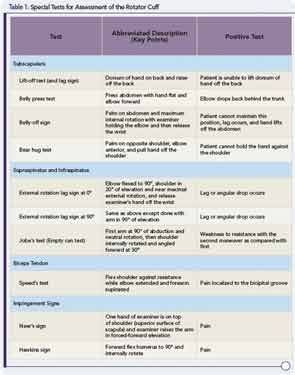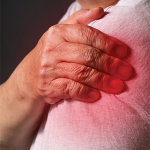In patients with rotator cuff disorders, special tests are very useful. These include Neer’s sign, Hawkins sign, Jobe’s test, lag signs, bear hug test, belly press test, and Speed’s test, to name a few (see Table 1). A description of special tests can be obtained from prior reviews of the literature.6,7 The sensitivity and specificity of these tests is variable and not assessed by studies using rigorous methodology. Special tests for instability, such as O’Brien’s sign, Kim’s test, and drawer tests, also are useful to assess for labral and ligamentous pathology.8
Diagnostic Testing
Diagnostic testing for shoulder disorders may include hematology and blood chemistry, imaging tests, and neurophysiological testing. This article will focus on diagnostic imaging.
X-rays: X-rays can assist in the diagnosis of common disorders such as glenohumeral osteoarthritis. X-rays are valuable in cases of trauma where a fracture or dislocation is suspected. Degenerative changes of the acromioclavicular joint are often seen on imaging. These degenerative changes are rarely the cause of the patient’s symptoms unless the patient has localized acromioclavicular joint pain. Superior migration of the humeral head and cystic changes of the greater tuberosity are often seen in patients with rotator cuff tears due to loss of compressive forces on the humeral head.9
Magnetic resonance imaging (MRI): MRI is a commonly used imaging modality for assessment of shoulder pain. With the evolution of fluid sensitive sequences, MRI is very useful to diagnose rotator cuff tears, other tendon tears, and assessment of muscle. MR arthrogram is indicated for assessment of labral pathology. However, the physician has to be sensitive to costs when ordering since MRI is an expensive imaging modality. Moreover, MRI is extremely sensitive but not specific for the diagnosis of rotator cuff tears.10 In most cases, the diagnosis of rotator cuff tear can be made based on the history and physical examination findings and does not require a MRI unless surgical intervention is indicated.
Ultrasound: Musculoskeletal ultrasound has gained popularity in the last decade. The sensitivity and specificity of ultrasound for diagnosing rotator cuff tears is comparable to MRI.10,11 Ultrasound is far less expensive than MRI, can be performed in an office setting, and permits dynamic evaluation. However, ultrasound is technically challenging and user dependent.

Conclusion
In summary, a thorough history and physical examination can assist in the diagnosis of most common etiologies of shoulder pain. Imaging modalities are useful and should be reserved in cases of trauma and for surgical decision making.

